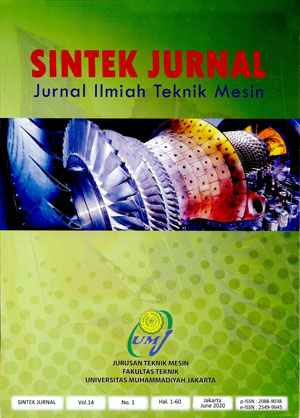Experimental Study of The Influence Use of Beeswax Against The Mechanical and Thermal Properties of Concrete
Main Article Content
Abstract
Article Details
- Articles published in SINTEK JURNAL are licensed under a Creative Commons Attribution-ShareAlike 4.0 International license. You are free to copy, transform, or redistribute articles for any lawful purpose in any medium, provided you give appropriate credit to the original author(s) and SINTEK JURNAL, link to the license, indicate if changes were made, and redistribute any derivative work under the same license.
- Copyright on articles is retained by the respective author(s), without restrictions. A non-exclusive license is granted to SINTEK JURNAL to publish the article and identify itself as its original publisher, along with the commercial right to include the article in a hardcopy issue for sale to libraries and individuals.
- By publishing in SINTEK JURNAL, authors grant any third party the right to use their article to the extent provided by the Creative Commons Attribution-ShareAlike 4.0 International license.
References
Handayani, T., Efisiensi Energi dalam Rancangan Bangunan, Jurnal Spektrum Sipil. 2010; 1: 102-108.
Y. Ismida, M. Amin, H. Umar, H. Amna, F. Amir, C. Akbar, Experimental Study of Heat-Absorbent Foam Concrete Wall Based Macro-Encapsulation of Beef Tallow/Damar Gum in Building, IOP Conference Series: Materials Science and Engineering, 2019: 1-7.
N.A. Prakoso, A.K. Lamahala, G. Sentanu, Kajian Penerapan Material pada Selubung Bangunan yang Mempengaruhi Kenyamanan Termal dan Visual, Reka Karsa, 2014; 1:1–12.
X. Sun, Q. Zhang, M.A. Medina, K.O. Lee, Energy and economic analysis of a building enclosure outfitted with a phase change material board (PCMB), Energy Convers. Manag, 2014; 83: 73–78.
P.P.D. Jakarta, Selubung bangunan - Panduan Pengguna Bangunan Gedung Hijau Jakarta, 2012.
A. Sharma, V. V. Tyagi, C.R. Chen, D. Buddhi, Review on thermal energy storage with phase change materials and applications, Renew. Sustain. Energy Rev., 2009; 13: 318–345.
A. Abhat, Low-temperature latent heat thermal energy storage: Heat storage materials, Sol. Energy. 1983; 30: 313–332.
Nader A. Nader, Bandar Bulshlaibi, Mohammad Jamil, Mohammad Suwaiyah, Mohammad Uzair, Application of Phase-Change Materials in Buildings, American Journal of Energy Engineering, 2015; 3: 46-52.
R. Revisdah, S. Mira, Pengaruh Air Soda Terhadap Kuat Tekan Beton, Prosiding SEMNASTEK FT-UMJ., 2015: 1-9.
I. Ahmad, Analisis Perbedaan Kuat Tekan Beton Tambahan Abu Terbang Dengan Beton Normal Yang Direndam Dalam Asam Sulfat Untuk Beton Mutu Rendah, Jurnal Konstruksia, 2011; 2: 23-30.
M. Islam, Perbandingan Analisi Kolom dengan Metode Analitis dan Metode Beda Hingga (Kasus Kolom Dengan Dimensi 300x300 mm2, f’ c = 20 MPa, fy = 400 MPa, As + As ’= 1% Ag), Jurnal Inersia, 2016; 8: 55–66.


